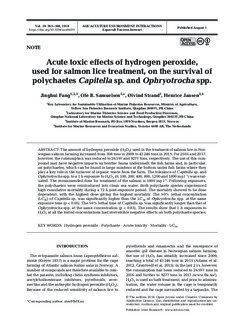| dc.contributor.author | Fang, Jinghui | |
| dc.contributor.author | Samuelsen, Ole Bent | |
| dc.contributor.author | Strand, Øivind | |
| dc.contributor.author | Jansen, Henrice M | |
| dc.date.accessioned | 2019-02-08T12:24:54Z | |
| dc.date.available | 2019-02-08T12:24:54Z | |
| dc.date.created | 2019-01-31T12:44:18Z | |
| dc.date.issued | 2018 | |
| dc.identifier.citation | Aquaculture Environment Interactions. 2018, 10 363-368. | nb_NO |
| dc.identifier.issn | 1869-215X | |
| dc.identifier.uri | http://hdl.handle.net/11250/2584589 | |
| dc.description.abstract | The amount of hydrogen peroxide (H2O2) used in the treatment of salmon lice in Norwegian salmon farming increased from 308 tons in 2009 to 43246 tons in 2015. For 2016 and 2017, however, the consumption was reduced to 26597 and 9277 tons, respectively. The use of this compound may have negative impacts on benthic fauna underneath the fish farms and, in particular, on polychaetes, which can be found in large numbers at the bottom under fish farms where they play a key role in the turnover of organic waste from the farm. The tolerance of Capitella sp. and Ophryotrocha spp. to a 1 h exposure to H2O2 (0, 100, 200, 400, 800, 1200 and 1800 mg l-1) was evaluated. The recommended dose for treatment of the salmon is 1800 mg l-1. Following exposures, the polychaetes were reintroduced into clean sea water. Both polychaete species experienced high cumulative mortality during a 72 h post-exposure period. The mortality showed to be dose dependent, with the highest dose giving the highest mortality. The 50% lethal concentration (LC50) of Capitella sp. was significantly higher than the LC50 of Ophryotrocha spp. at the same exposure time (p < 0.05). The 50% lethal time of Capitella sp. was significantly longer than that of Ophryotrocha spp. at the same concentration (p < 0.05). The results show that 1 h exposures to H2O2 at all the tested concentrations had irreversible negative effects on both polychaete species. | nb_NO |
| dc.language.iso | eng | nb_NO |
| dc.title | Acute toxic effects of hydrogen peroxide, used for salmon lice treatment, on the survival of polychaetes (Capitella sp. and Ophryotrocha spp.) | nb_NO |
| dc.type | Journal article | nb_NO |
| dc.type | Peer reviewed | nb_NO |
| dc.description.version | publishedVersion | nb_NO |
| dc.source.pagenumber | 363-368 | nb_NO |
| dc.source.volume | 10 | nb_NO |
| dc.source.journal | Aquaculture Environment Interactions | nb_NO |
| dc.identifier.doi | 10.3354/aei00273 | |
| dc.identifier.cristin | 1670279 | |
| dc.relation.project | Norges forskningsråd: 263870 | nb_NO |
| cristin.unitcode | 7431,17,0,0 | |
| cristin.unitcode | 7431,12,0,0 | |
| cristin.unitcode | 7431,0,0,0 | |
| cristin.unitname | Sykdom og smittespredning | |
| cristin.unitname | Bentiske ressurser og prosesser | |
| cristin.unitname | Havforskningsinstituttet | |
| cristin.ispublished | true | |
| cristin.fulltext | original | |
| cristin.qualitycode | 1 | |
